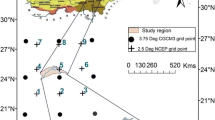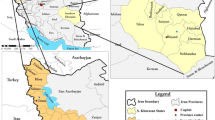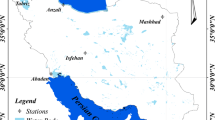Abstract
In this study, a Multivariate Adaptive Regression Spline (MARS) based lead seven days minimum and maximum surface air temperature prediction system is modelled for station Chennai, India. To emphasize the effectiveness of the proposed system, comparison is made with the models created using statistical learning technique Support Vector Machine Regression (SVMr). The analysis highlights that prediction accuracy of MARS models for minimum temperature forecast are promising for short term forecast (lead days 1 to 3) with mean absolute error (MAE) less than 1 °C and the prediction efficiency and skill degrades in medium term forecast (lead days 4 to 7) with slightly above 1 °C. The MAE of maximum temperature is little higher than minimum temperature forecast varying from 0.87 °C for day-one to 1.27 °C for lag day-seven with MARS approach. The statistical error analysis emphasizes that MARS models perform well with an average 0.2 °C of reduction in MAE over SVMr models for all ahead seven days and provide significant guidance for the prediction of temperature event. The study also suggests that the correlation between the atmospheric parameters used as predictors and the temperature event decreases as the lag increases with both approaches.




Similar content being viewed by others
References
Donald Ahrens C 2011 Essentials of meteorology — An invitation to the atmosphere; VI ed, Cengage Learning.
Farag Aly and Mohamed Refaat M 2004 Regression using Support Vector Machines: Basic Foundations; Tech. Rep. CVIP Laboratory, University of Louisville.
Friedman Jerome H 1991 Multivariate adaptive regression spline; Ann. Stat. 19 1–141.
Ghosh S 2010 SVM-PGSL coupled approach for statistical downscaling to predict rainfall from G C M output; J. Geophys. Res. 115 D22102, doi:10.1029/2009JD013548.
Kramer Oliver and Gieseke Fabian 2011 Short-term wind energy forecasting using support vector regression, soft computing models in industrial and environmental applications; 6th Int. Conf. SOCO 2011; Adv. Intelligent Soft Comput. 87 271–280.
Leathwick J R, Rowe D, Richardson J, Elith J and Hastie T 2005 Using multivariate adaptive regression splines to predict the distributions of New Zealand’s freshwater diadromous fish; Freshw. Biol. 50 2034–2052.
Leathwick J R, Elith J and Hastie T 2006 Comparative performance of generalized additive models and multivariate adaptive regression splines for statistical modelling of species distributions; Ecol. Model. 199 188–196.
Lee Tian-Shyug, Chiu Chih-Chou, Chou Yu-Chao and Lu Chi-Jie 2006 Mining the customer credit using classification and regression tree and multivariate adaptive regression splines; Comput. Stat. Data Anal. 50 1113–1130.
Lin Shengpan et al. 2012 Evaluation of estimating daily maximum and minimum air temperature with MODIS data in east Africa; Int. J. Appl. Earth Obs. 18 128–140.
Nag P K and Nag A 2009 Vulnerability to heat stress: Scenario in western India; National Institute of Occupational Health, Ahmedabad.
Ortiz-Garcia E G et al. 2012 Accurate local very short-term temperature prediction based on synoptic situation support vector regression banks; Atmos. Res. 107 1–8.
Paniagua-Tineo et al. 2011 Prediction of daily maximum temperature using a support vector regression algorithm; Renew. Energy 36 3054–3060.
Smola Alex J and Scholkopf Bernhard 2003 A Tutorial on Support Vector Regression; Statistics and Computing 14 199–222.
Taylor Andrew A and Leslie Lance M 2005 A single-station approach to model output statistics temperature forecast error assessment; Wea. Forecasting 20 1006–1019.
Vapnik V 1995 The Nature of Statistical Learning Theory; Springer, New York.
Zakeri I F, Adolph A L, Puyau M R, Vohra F A and Butte N F 2010 Multivariate adaptive regression splines models for the prediction of energy expenditure in children and adolescents; J. Appl. Physiol. 108 128–136.
Author information
Authors and Affiliations
Corresponding author
Rights and permissions
About this article
Cite this article
Ramesh, K., Anitha, R. MARSpline model for lead seven-day maximum and minimum air temperature prediction in Chennai, India. J Earth Syst Sci 123, 665–672 (2014). https://doi.org/10.1007/s12040-014-0434-z
Received:
Revised:
Accepted:
Published:
Issue Date:
DOI: https://doi.org/10.1007/s12040-014-0434-z




